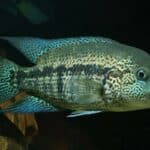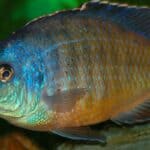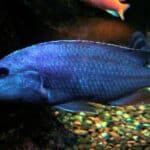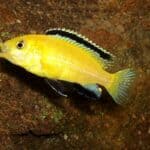The Bumblebee cichlid (Pseudotropheus crabro) is a beautiful fish with striking black and yellow colors, hence its popular name Bumblebee. It is a resistant species, active in the aquarium and aggressive with other fish.
They have a wide distribution along Lake Malawi, living among the rocks, which places them within the classification of the Mbuna cichlids.
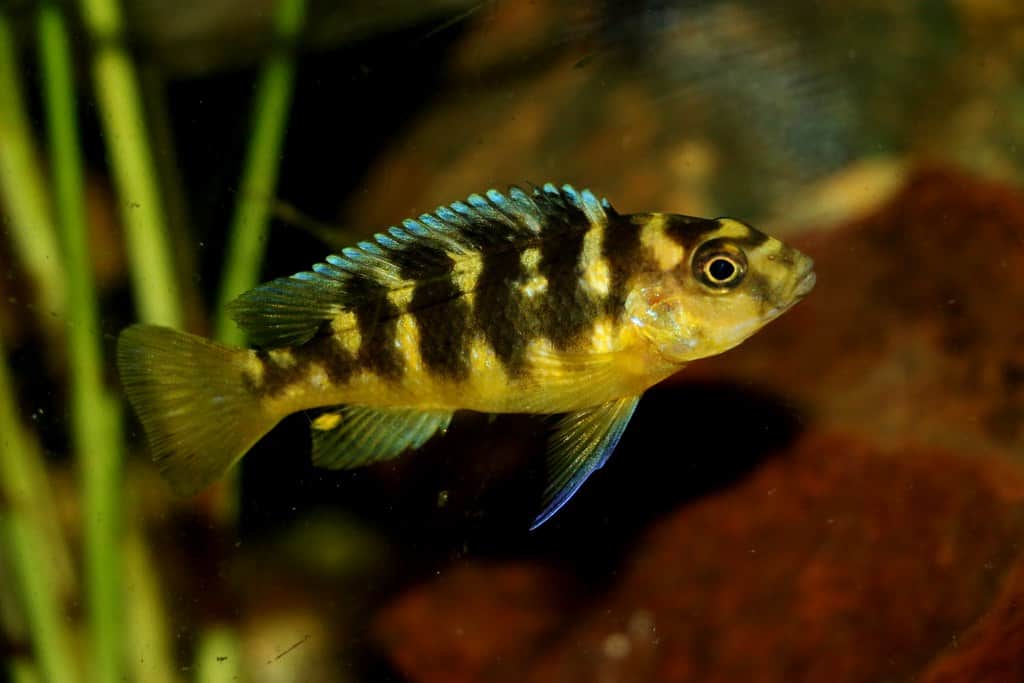
Species Summary
Bumblebee Cichlid, also known as Hornet Cichlid, is a tropical freshwater cichlid species endemic to Lake Malawi in East Africa. It occurs along rocky coastlines and reefs formations on the coasts of Mozambique and Malawi.
These cichlids are known as Mbuna. Mbuna are fish that inhabit the rocky shores of Lake Malawi. The word Mbuna means “rockfish” in the native language of the traditional communities in that region.
They are found over a large expanse of Lake Malawi in the wild. They live in many different habitats but prefer to live close to rocks and areas with many caves. They eat various foods, from crustaceans, biofilm, fingerlings to other fish, eggs, and larvae.
In general, the Bumblebee Cichlid is considered a very aggressive Mbuna and is regarded as a suitable species for more experienced aquarists.
Care Guide
These fish are very resistant but aggressive, hindering their maintenance in community aquariums. Even though it is not recommended for beginners, it is an easy-to-care fish, which does not exclude knowing the species in-depth, habits, and behaviors.
This African cichlid is a very showy fish when well cared for, with its wonderful aberrant pattern with black and yellow hues. When given a balanced diet and a suitable aquarium, these tropical freshwater fish will show their best colors.
Like any other species, the Bumblebee Cichlid has its peculiarities, which will be covered and detailed in the following topics.
Tank Size
As an Mbuna is considered quite aggressive due to territorialism, the tank’s space must be well dimensioned about the number of inhabitants. For starters, a 39″ x 15″ aquarium – approximately 40 gallons – with lots of hiding places can be used to house a trio; as they are very aggressive fish that live among rocks, an essential factor is the width of the aquarium due to the hardscape.
Tankmates
As they are aggressive fish, there can be problems with other animals and individuals.
The choice of tank mates is an essential step towards the success of an African cichlid aquarium due to its territoriality and aggressiveness. Pseudotropheus crabro must be kept with other Mbuna of similar size and behavior to avoid more peaceful species, which will only suffer passive aggression.
As much as it is not recommended, you can still keep this fish in community aquariums with other Mbunas. But, remember that the aquarium must be large and contain lots of hiding places.
Try to keep only one male Bumblebee Cichlid per aquarium, as their aggression is aimed at males of the same species and similar fish.
Same Species Tanks
It presents a high degree of aggressiveness, even among the Mbunas, but it is more restricted to males of the same species and other fish of similar colors. It is commonly kept in the same species tank.
It must have a large aquarium with rocks and crevices as caves and hiding places. As they are harem fish, you should keep at least two females for each male; keeping a male with several females is common to reduce harassment and aggression over just one female.
To keep more than one male per tank, it is recommended to have an aquarium above 80 gallons with many rock caves and hiding places.
Water Parameters
Bumblebee Cichlids are extremely hardy fish that suit a range of specific physicochemical parameters.
In terms of ideal conditions (which is what every aquarist looks for to keep their fish), the tank must have a stable and constant temperature between 75 and 82 degrees. Avoid soft and acidic water conditions, which are typically ideal for South American cichlids.
This species of African cichlid lives in water that is tending towards the alkaline side of the scale, its ideal pH being between 7.6 and 8.4 and the hardness at 10-25°H.
What to Put in Their Tank
As for any other aquatic animal, an aquarium heater and a filtering system are essential to keep the tank with Bumblebee Cichlid healthy.
The substrate must be fragile and without sharp edges to facilitate the excavations made by them and avoid accidents; sandy substrates are ideal. As for any Mbuna cichlid, the aquarium for the species should contain numerous rocks forming a rocky wall to take refuge and demarcate territory, with some free space for swimming.
To provide territories and hiding places for the animals, add rocks grouped in aquascaping, thus forming different caves of different sizes. The stones must be carefully buried and supported, thus minimizing the risk of collapse; with this, a fish can get stuck, or rock can hit the glass. Don’t forget to keep areas open for fish to swim.
The most important thing to maintain in a Mbunas aquarium is the rocks and caves, along with the easily excavated substrate. The stones will provide several places for each fish to form and protect their territory and be used as a hiding place in case of aggression by a dominant male. By feeding on algae and biofilms present in the medium, the intense luminosity and the encouragement of algae growth are beneficial to the system.
Common Diseases
Bumblebee Cichlids are highly resistant fish, but like all Mbuna, they are subject to Malawi bloat.
Malawi bloat is a sporadically occurring pathological condition in ornamental African cichlids. This pathological condition is not restricted to African Lake Malawi cichlids but extends to other family members.
The causes of bloat in African cichlids are known, and many have even been scientifically published. There is often more than one causative agent of this disease and, for this reason, uncertainties arise among most laypersons. Another important cause of these uncertainties is the lack of a confirmatory laboratory diagnosis. This is not routine in fishkeeping, with a few rare exceptions, or when there are investigations of a scientific nature.
There is also debate about inadequate nutrition. Bumblebee cichlids need a high percentage of animal protein along with adequate quantities of vegetables in their diet.
The direct cause of Malawi bloat is pathogenic bacteria. Malawi bloat is a systemic bacterial infection originating from a disordered proliferation of bacteria.
Ammonia in water and inadequate nutrition are not causes but conditions that predispose a bacterium to cause bloat.
Food and Diet
This species is omnivorous, feeding on small invertebrates, algae, biofilms (Biofilm is a biological system composed of algae, bacteria, and invertebrates, commonly known as Periphyton or Aufwuchs), crustaceans, fish eggs, small fish, among other things.
In aquariums, they will easily accept commercial feed in flakes and pellets, spirulina, and high-quality prepared food for Lake Malawi cichlids.
Experienced aquarists claim that this species needs more animal protein than other Mbunas because of its natural environment diet; even so, vegetable matter should be offered in their daily diet. Fresh vegetables like nori seaweed and bleached ones like spinach and zucchini are excellent snacks for these fish.
It is always good to feed them small amounts, several times a day, rather than a single serving of food. Providing a varied and balanced diet is essential for achieving its full potential. These are usually fish that are always hungry.
Lifespan
In an aquarium with all the correct parameters kept stable and with an ideal diet, this cichlid can live for up to 10 years, the most common being around eight years.
In nature, these animals live less, as they are predisposed to diseases, attacks from other animals, and environmental causes.
Appearance
This species is characterized by a thick and robust body in males and females. A dominant mature male has dark blue vertical bars on his black base body. But it can change and turn completely black, especially during mating; in addition, some males display bright blue spots along their front portion.
The female has a mixture of zigzag and dark brown vertical bars on her body. This mixture of colors sometimes fades to golden around the belly region. You can also see a horizontal brown bar going to the tail.
Size
In aquariums, the Bumblebee Cichlid fish is on average 4 inches in size, but some males reach up to 6 inches.
Behavior and Temperament
Like most Mbunas, they show intense intra-species aggressiveness. Its aggressiveness is more restricted to males of the same species and fish of similar patterns and colors.
As they are harem fish, it is always recommended to keep at least one male and three females so they won’t get too stressed because of persecution on the male’s part.
Breeding
Bumblebee cichlid is not one of the easiest species to breed in domestic aquariums, but it can be done without significant problems. You will need to start with several young fish and remove any other males that become sub-dominant, as the dominant will kill any rivals.
It is a maternal mouth incubator species; after spawning and fertilization, the mother keeps the eggs in her mouth.
During the reproductive process, the male will have very dark colors. It will be shaking and circling the female to move her to a flat rock or a hole in the substrate in its territory, then fertilization begins.
The female lays about 20 – 60 eggs and places them in her mouth. The male will then dilate his anal fin, which has a pattern similar to the egg colors. The female will get confused by this pattern and try to put them in her mouth; this encourages the male to release sperm, fertilizing the eggs.
The eggs will stay in the mother’s mouth for up to 21 days. But, remember that the male may harass the female during this period, causing the female to ingest the eggs. Therefore, the idea is to form visual blocks so that the female can hide.
Gender Differences: Male vs. Female
There is apparent sexual dimorphism. Males have more pointed dorsal and anal fins, in addition to a more significant number of ocelli. During the breeding season, males change their color, becoming darker.
Bumblebee Cichlid Fun Facts
This species is opportunistic when it feeds on what it can catch, but it is specialized in cleaning parasites in the catfish Bagrus meridionalis.
Bumblebee Cichlid was once contained within the genera Maylandia and Melanochromis.
Given its extremely aggressiveness, it is not a good fish for beginners, but it makes a great addition to more advanced aquarists.
Males can appear significantly larger than females and fish bred in captivity do not have the same magnificent color pattern as wild fish.
Several populations are found along Lake Malawi, except in the northern region.
References
Bogutskaya, N.G., 2007. Preliminary assignment of coordinates to type localities in the Catalog of Fishes. Unpublished dbf file.
Konings, A., 1990. Ad Konings’s book of cichlids and all the other fishes of Lake Malawi. T.F.H. Publications, Inc.
Maréchal, C., 1991. Pseudotropheus. p. 401-415. In J. Daget, J.-P. Gosse, G.G. Teugels and D.F.E. Thys van den Audenaerde (eds.) Check-list of the freshwater fishes of Africa (CLOFFA). ISNB, Brussels; MRAC, Tervuren; and ORSTOM, Paris.



